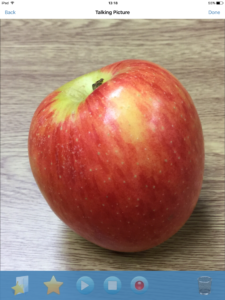Words and Pictures
The title is a reference for those old enough to remember the name of the educational T.V. programmes of the same name. In the first article we mentioned ‘Talking Pictures’, that is the use of images and video, as a stimulus to help students generate discussion and record their ideas related to what they see. We’ll consider some suggestions of how these could be used across the key stages in ways appropriate to pupil’s age and available technology.
 Young children are hands-on, they interact and learn concepts through handling, touching, feeling, and physically manipulating things through play, exploration and guided learning activities. This is called concrete learning. In a small group or in a one to one, objects could be handled and talked about in relation to their properties; weight, colour, texture, smell and in the case of edibles such as fruit, even tasted – food allergies aside. Handling items and asking appropriate questions creates great opportunities for oral language. To capture what children are saying in real time, have a digital recording device handy to record the talk.
Young children are hands-on, they interact and learn concepts through handling, touching, feeling, and physically manipulating things through play, exploration and guided learning activities. This is called concrete learning. In a small group or in a one to one, objects could be handled and talked about in relation to their properties; weight, colour, texture, smell and in the case of edibles such as fruit, even tasted – food allergies aside. Handling items and asking appropriate questions creates great opportunities for oral language. To capture what children are saying in real time, have a digital recording device handy to record the talk.
Another addition to this would be to have large post-it notes for each child to write a word and stick it on, or next to, the object. Emergent writers could do this too.
Technology can be used to enable each pupil to take a picture of their object and word they have written in an App and record themselves talking about the items. Fotobabble can do this simply. It then creates a media file that can stay on the app or be uploaded to an account on the web. Talking Pictures by Ivan Perre allows talking pictures to be emailed from the app as video files, so these can be put up on the school website.
Moving on to another app for those age seven and above, try Photospeak 3D, see the animated video – any picture can be made to talk, even hand drawings. Have the pupils make a photo of the object then record over it, reading out their sentence describing the object. Use that as a stimulus to extend written or spoken descriptions.
If your students are into graphic novels, or relate to that style, then try Comic Life from Plasq for computer or tablet. With some reluctant older writers, I have started off with providing either a beginning, middle or an ending, made up as a graphic novel style page and after some discussion it has been a successful method for some written prose.
Writing is linked to purpose and audience. Challenge students to come up with an advert for the subject you teach. Do not require them to write a script first! Get them to try some initial ideas. In the middle of trying to recall what they want to say to the camera, they will grab for a pen and paper and begin writing down their rough script. Review the adverts and use the reviews to help them improve on it, while at the same time showing them how to improve the written script layout.
Creating short films or an animation will involve planning a story board. For focusing just on scripting stage directions, challenge them to create films in the style of a Silent Movie – there are apps out there for this too!
But what if it’s a geography topic on Rock types? How about a conversation between two rock types placed into Power Point slides with speech bubbles. Everyone in school has access to a Power Point type application.
Have fun. In the next article – Notetaking made easier, looking at audio notetaking.